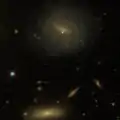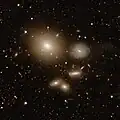| NGC 1189 | |
|---|---|
 NGC 1189 (NASA/ESA HST) | |
| Observation data (J2000.0 epoch) | |
| Constellation | Eridanus |
| Right ascension | 03h 03m 24.47s [1] |
| Declination | −15° 37′ 24.48″ [1] |
| Redshift | 0.008486 [1] |
| Heliocentric radial velocity | 2544 ± 1 km/s [1] |
| Distance | 105 Mly |
| Apparent magnitude (V) | 13.80 [2] |
| Apparent magnitude (B) | 14.50 [2] |
| Characteristics | |
| Type | SB(s)dm:[1] |
| Apparent size (V) | 1.7 x 1.5 [1] |
| Other designations | |
| PGC 11503, MCG -3-8-61, HCG 22C | |
NGC 1189 is a barred spiral galaxy approximately 105 million light-years away from Earth in the constellation of Eridanus.[1] It was discovered by American astronomer Francis Leavenworth on December 2, 1885 with the 26" refractor at Leander McCormick Observatory.[3]
NGC 1189 has extended clumpy star formation throughout its spiral arms with remarkably little associated stellar light, which is striking in the color images.[4]
Together with NGC 1190, NGC 1191, NGC 1192 and NGC 1199 it forms Hickson Compact Group 22 (HCG 22) galaxy group.[5] Although they are considered members of this group, NGC 1191 and NGC 1192 are in fact background objects, since they are much further away compared to the other members of this group.[4]
Image gallery
 NGC 1189 with other members of the HCG 22 galaxy group (SDSS)
NGC 1189 with other members of the HCG 22 galaxy group (SDSS) NGC 1189 and nearby galaxies (SDSS)
NGC 1189 and nearby galaxies (SDSS) Complete view of HCG 22 with legacy surveys
Complete view of HCG 22 with legacy surveys
See also
References
- 1 2 3 4 5 6 7 "NASA/IPAC Extragalactic Database". ned.ipac.caltech.edu. Retrieved December 9, 2017.
- 1 2 "Revised NGC Data for NGC 1189". spider.seds.org. Retrieved December 9, 2017.
- ↑ "Data for NGC 1189". www.astronomy-mall.com. Retrieved December 9, 2017.
- 1 2 Johnson, Kelsey E.; et al. (2007). "The Infrared Properties of Hickson Compact Groups". The Astronomical Journal. 134 (4): 1522–1543. arXiv:0706.4461. Bibcode:2007AJ....134.1522J. doi:10.1086/520921. S2CID 38349471.
- ↑ "A members-only galaxy club". www.spacetelescope.org. Retrieved December 9, 2017.
External links
Wikimedia Commons has media related to NGC 1189.
- NGC 1189 on WikiSky: DSS2, SDSS, GALEX, IRAS, Hydrogen α, X-Ray, Astrophoto, Sky Map, Articles and images
- SEDS
This article is issued from Wikipedia. The text is licensed under Creative Commons - Attribution - Sharealike. Additional terms may apply for the media files.